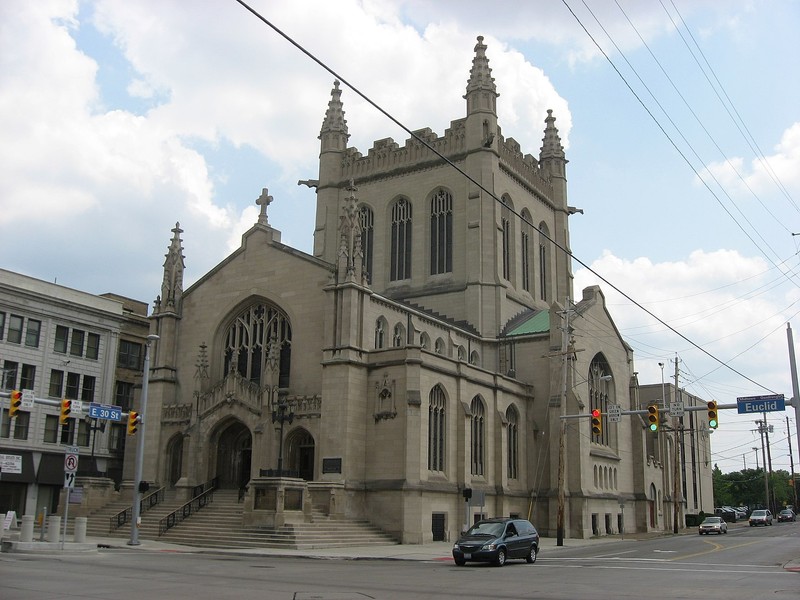First Methodist Church
Introduction
Text-to-speech Audio
Images
2009 photo of Cleveland's First Methodist Church (circa 1905)

Backstory and Context
Text-to-speech Audio
The First United Methodist Church of Cleveland was established in the mid-nineteenth century and moved into this historic church edifice in 1905. The church building served the congregation for 105 years. In 2010, the church merged with a smaller, nearby church, leaving this building vacant. A restaurant magnate purchased the building at an auction in 2018 and received government aid and tax benefits to preserve the structure, although interior work will result in its transformation from a church into a space suitable for weddings, banquets, and other large events.
Before Cleveland grew into the county seat, the population increased in Newburgh (to the south of present-day Cleveland) because of its high-ground location away from Lake Erie. The area away from the lake made mosquitoes and malaria less problematic. Engineering made it possible for the city to grow towards Lake Erie. Methodist preachers arrived in Newburgh in 1818 and with new converts and migration to the city, the congregation grew slowly at first and Cleveland's First Methodist congregation was officially established in 1827. Officially known as the First Methodist Episcopal Society, the church met in rented rooms and homes until 1841. In that year, the Methodist society formally established the First Methodist Church of Cleveland, the first official Methodist church within Cleveland's original boundaries. The congregation built a permanent church in 1869, and then a much more refined structure in 1874, located on the outskirts of Cleveland. The church remained on the city's fringes until it moved to its historic location in 1904.
In addition to its significance to the Methodist religion, the structure has served as a recognizable city landmark. During the last quarter of the nineteenth century and into the early twentieth century, the Beaux Arts Architectural Style dominated America and Europe designs, only dying off when the Great Depression arose. While Beaux Arts served as the foundation of many plans, American architects routinely borrowed and mixed several styles from various classic European and American Colonial forms, demonstrated by First Methodist Church's Latin-cross floor plan large Gothic tower.
The church functioned as a cornerstone of the city's Methodist faith for nearly a century by establishing missions and seeding other Methodist churches. Though the church has now moved to a new location, the latest renovation plans include leaving the exterior designs intact and much of the interior, thus preserving its architecture and appearance.
Sources
Coates, William R. "Cleveland's Churches and Missions." History of Churches in Cleveland, OH. history.rays-place.com. Accessed October 15, 2020. http://history.rays-place.com/oh/cuyahoga/cleveland-church.htm.
Encyclopedia of Cleveland History. "First United Methodist Church of Cleveland." Case Western Reserve University. case.edu. Accessed October 15, 2020.
https://case.edu/ech/articles/f/first-united-methodist-church-cleveland
--- --- --- "Newburgh." Case Western Reserve University. case.edu. Accessed October 15, 2020. https://case.edu/ech/articles/n/newburgh
Grabowski, John J. "Turks in Cleveland from the Encyclopedia of Cleveland History." Teaching Cleveland Digital (blog). teachingcleveland.org. January 30, 2013. http://teachingcleveland.org/category/ethnic-history-of-cleveland/page/5/.
Jarboe, Michelle. "Businessman Tony George is winning bidder for historic Euclid Avenue church, at $489,500." The Plain Dealer (Cleveland). January 30, 2019. Real Estate News sec. Located digitally at https://www.cleveland.com/realestate-news/2018/02/businessman_tony_george_wins_b.html.
By User:Nyttend - Own work, Public Domain, https://commons.wikimedia.org/w/index.php?curid=7382375
